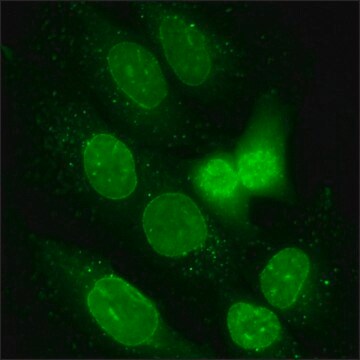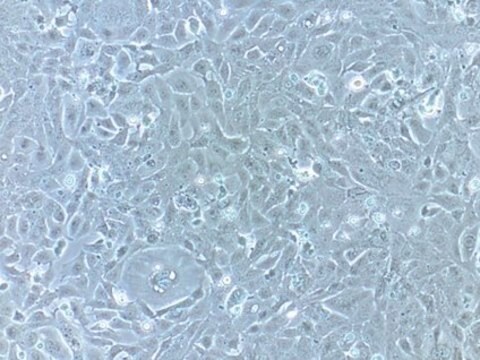HeLa-Mitotrap-Ap1g1-FKBP
15042203, human cervix, Epithelial, polygonal
About This Item
Empfohlene Produkte
Produktbezeichnung
HeLa-Mitotrap-Ap1g1-FKBP, 15042203
Biologische Quelle
human cervix
Beschreibung
Human cervix carcinoma, knocksideways, rapid protein inactivation by rerouting to mitochondria for functional studies, adaptor protein (Ap1g1), genetically modified
Wachstumsmodus
Adherent
Morphologie
Epithelial, polygonal
Methode(n)
cell culture | mammalian: suitable
Versandbedingung
dry ice
Lagertemp.
−196°C
Beschreibung der Zelllinie
The HeLa-Mitotrap-Ap1g1-FKBP is a stably transfected HeLa cell line expressing two proteins containing rapamycin binding activity. To generate this cell line, the HeLa-Mitotrap cell line, ECACC 15042201, expressing a single construct expressing a mitochondrial trapping protein containing an FRB domain, (the term FRB refers to protein containing a FKBP12 and Rapamycin Binding (FRB) domains within the mTOR (mammalian Target of Rapamycin) protein, has been transfected with a second construct expressing siRNA-resistant subunits, FKBP-tagged subunits of the adaptor protein (AP1) complexes of clatharin-coated vesicles (CCVs) together with an FKBP and rapamycin-binding domain with a mitochondrial targeting signal. An FKBP domain, FKBP is a cellular chaperone protein and prolyl isomerase which is a target for rapamycin binding and will dimerize with FRB-containing protein. Upon treatment with rapamycin a target protein containing an FKBP domain, e.g, AP1, will dimerize with FRB domains and sequester the resulting protein complexes to the mitochondria. Treatment of cell lines containing both FRB and FKBP rapamycin binding proteins can sequester target proteins to the mitochondria within minutes of treatment rendering the cells ready for immediate assay.
The ?-FKBP construct was based on a pIRESneo2 plasmid encoding an siRNA-resistant form of a, which includes a brain-specific insert that acts as an epitope tag (Motley et al., 2006, PMID: 17035630). The FKBP coding sequence was amplified by PCR and inserted into the linker region of ?. The open reading frame was sequenced, the plasmid was transfected into HeLaM cells, and clonal cell lines were isolated as previously described (Motley et al., 2006).
Nährmedium
Subkultur-Routine
Sonstige Hinweise
Haftungsausschluss
Hier finden Sie alle aktuellen Versionen:
Analysenzertifikate (COA)
Leider sind derzeit keine COAs für dieses Produkt online verfügbar.
Wenn Sie Hilfe benötigen, wenden Sie sich bitte an Kundensupport
Besitzen Sie dieses Produkt bereits?
In der Dokumentenbibliothek finden Sie die Dokumentation zu den Produkten, die Sie kürzlich erworben haben.
Unser Team von Wissenschaftlern verfügt über Erfahrung in allen Forschungsbereichen einschließlich Life Science, Materialwissenschaften, chemischer Synthese, Chromatographie, Analytik und vielen mehr..
Setzen Sie sich mit dem technischen Dienst in Verbindung.



